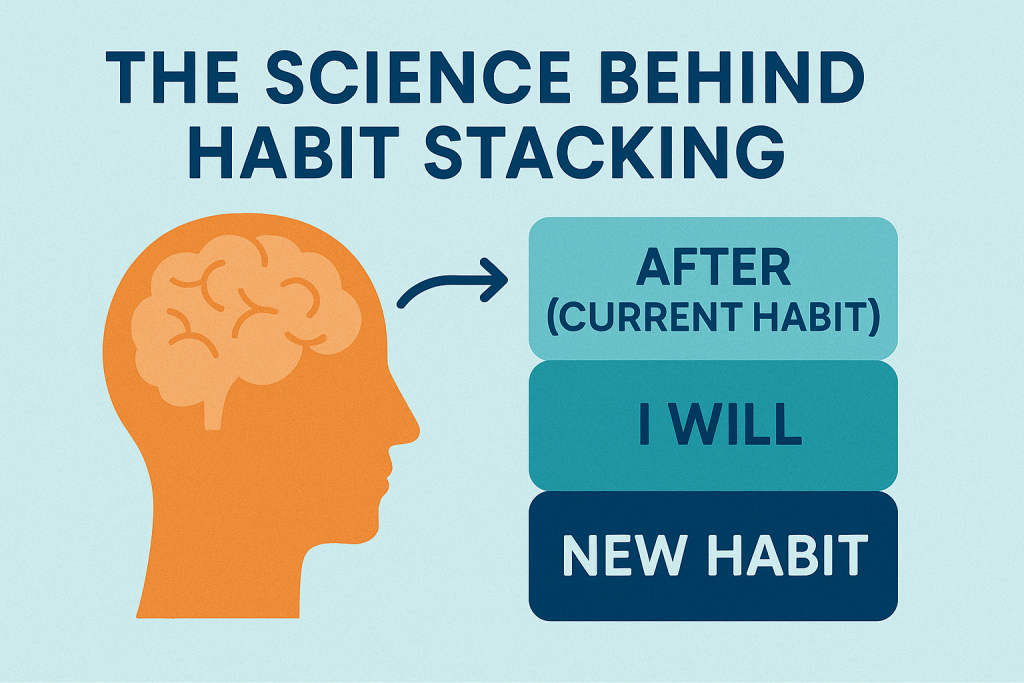Creating new habits can feel like pushing a boulder uphill. You may start with strong intentions—waking up earlier, exercising daily, or practicing mindfulness—but sustaining those habits is often the real challenge. That’s why understanding the science behind habit stacking is proving so valuable. This method, rooted in behavioral psychology, involves pairing a new behavior with an existing one, making it easier for your brain to accept and automate the change. As our lives become increasingly busy, strategies that simplify habit formation are more relevant than ever.
Rooted in behavioral psychology, habit stacking involves pairing a new behavior with an existing one, making it easier for your brain to accept and automate the change. As our lives become increasingly busy, strategies that simplify habit formation are more relevant than ever. This article explores the science behind habit stacking, its growing popularity in personal development and workplace productivity, and how you can implement it successfully in your own life.

What Is Habit Stacking?
At its core, habit stacking is the practice of linking a new habit with an already-established one. The idea was popularized by James Clear in his book Atomic Habits, but the foundational concept has roots in the psychological principle known as “cue-dependent learning.”
Instead of relying on motivation or willpower, which are notoriously inconsistent, habit stacking builds on routines that are already ingrained. For example:
- After I brush my teeth, I will floss.
- After I start my coffee machine, I will review my to-do list.
- After I close my laptop at work, I will do five minutes of stretching.
The existing habit acts as a cue, prompting the new behavior. Over time, the two actions become neurologically linked through a process called synaptic consolidation.
The Neuroscience of Habit Stacking
Research in neuroscience reveals that our brains are wired to form habits through a loop of cue, routine, and reward. According to a 2012 study published in Neuron, habits are encoded in the basal ganglia, a brain structure that supports procedural learning and routine behaviors. Once a habit loop is formed, the brain becomes less active in decision-making during that activity, freeing up cognitive resources for other tasks.
When you stack habits, you’re essentially hijacking this natural loop by introducing a new behavior right after a well-established one. The brain recognizes the familiar cue and is more receptive to the new routine, increasing the odds of consistency.
Moreover, a 2021 study from the Journal of Behavioral Medicine found that habit formation is significantly accelerated when new behaviors are linked to existing daily routines. Participants who used this method were more likely to stick with wellness-related goals compared to those who attempted to create entirely new routines from scratch.
Why Habit Stacking Is Trending in 2025
In a world saturated with productivity hacks and life optimization strategies, habit stacking has gained popularity for one reason: it works. As more people seek sustainable behavioral change in areas like health, work-life balance, and digital wellness, habit stacking has become a staple method used by coaches, therapists, and organizational leaders.
Here’s why it’s trending:
- Time-Efficiency – Habit stacking saves time by anchoring new actions to ones you’re already doing, eliminating the need to build entirely new routines.
- Scalability – You can start small and build progressively. One habit stack can grow into a more complex routine as your consistency improves.
- Applicability – From remote work schedules to daily fitness, habit stacking fits into virtually any lifestyle or goal.
- Technology Integration – With the rise of habit-tracking apps like Habitica, Streaks, and Productive, habit stacking is now easier to plan, track, and evaluate than ever before.
How to Build Effective Habit Stacks
Building a successful habit stack isn’t about cramming more tasks into your day. It’s about strategically layering behaviors so they feel automatic. Follow this step-by-step guide to create your own habit stack.
1. Identify Your Anchor Habit
Choose a habit you already do consistently and without much thought. This is your “anchor.” Good anchor habits include brushing your teeth, making coffee, walking the dog, or checking your email.
2. Choose a Small, Meaningful Action
Pick a new habit that’s simple and actionable. Instead of saying “meditate more,” opt for “take three deep breaths” or “open my meditation app.” The easier it is, the more likely you’ll follow through.
3. Use Clear, Structured Prompts
Formulate your stack using the format:
“After [current habit], I will [new habit].”
Examples:
- After I finish lunch, I will go for a 5-minute walk.
- After I hang up a work call, I will write down one key takeaway.
4. Start Small, Then Scale
Resist the urge to add five new habits at once. Begin with just one stack and build on it once it becomes second nature.
5. Reinforce the Reward Loop
Celebrate your wins—even the small ones. A quick mental pat on the back, a smile, or checking off a habit tracker can reinforce the behavior.
Common Mistakes to Avoid
Despite its simplicity, habit stacking can backfire if implemented poorly. Here are some common pitfalls:
- Stacking on an unstable habit: If your anchor habit is irregular (like “when I go for a run,” which might not happen daily), it won’t provide a reliable cue.
- Being too ambitious: Complex or time-consuming new habits can lead to burnout. Start small.
- Skipping personalization: Not every stack fits every lifestyle. Choose stacks that align with your natural routines and preferences.
Real-World Applications of Habit Stacking
The concept of habit stacking has applications well beyond personal development:
In Health
- After pouring morning water, take vitamins.
- After brushing teeth, do 10 squats.
Workplace Productivity
- After opening your inbox, reply to priority emails first.
- After every meeting, update your task manager.
In Mental Wellness
- After locking your phone at night, journal for 3 minutes.
- After you get home from work, play calming music for 10 minutes.
These micro-changes accumulate and lead to more substantial transformations over time.
The Future of Habit Formation: Where Does Stacking Fit In?
As behavioral science integrates more deeply with wearable tech and digital health platforms, habit stacking is poised to become even more data-driven. Personalized AI-based suggestions, informed by behavioral patterns and biometrics, may soon provide real-time prompts for habit stacking in contexts like sleep hygiene, mental health, and even time management.
Leading wellness apps are already experimenting with AI-generated routines and behavioral nudges that follow the habit stacking model. The goal is not only to form habits—but to sustain them intelligently and contextually.
Final Thoughts
Habit stacking isn’t just a productivity trend; it’s a science-backed method that makes behavior change more attainable. By anchoring new behaviors to familiar routines, we can leverage the brain’s natural wiring for habit formation—making transformation not only possible but sustainable.
Whether you’re looking to build healthier habits, increase efficiency, or simply find structure in a chaotic day, habit stacking offers a framework that’s both practical and adaptable to modern life.
References:
- Wood, W., & Rünger, D. (2016). “Psychology of Habit.” Annual Review of Psychology, 67, 289–314. https://doi.org/10.1146/annurev-psych-122414-033417
- Clear, J. (2018). Atomic Habits. Avery Publishing.
- Lally, P., van Jaarsveld, C. H. M., Potts, H. W. W., & Wardle, J. (2010). “How are habits formed: Modelling habit formation in the real world.” European Journal of Social Psychology, 40(6), 998–1009. https://doi.org/10.1002/ejsp.674
- Gardner, B., & Rebar, A. L. (2019). “Habit Formation and Behavior Change.” Oxford Research Encyclopedia of Psychology. https://doi.org/10.1093/acrefore/9780190236557.013.21
- Judah, G., Gardner, B., & Aunger, R. (2013). “Forming a flossing habit: An exploratory study of the psychological determinants of habit formation.” British Journal of Health Psychology, 18(2), 338–353. https://doi.org/10.1111/j.2044-8287.2012.02086.x






